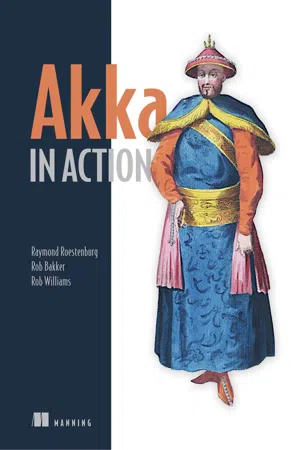
- 448 pages
- English
- ePUB (mobile friendly)
- Available on iOS & Android
Akka in Action
About this book
Summary Akka in Action is a comprehensive tutorial on building message-oriented systems using Akka. The book takes a hands-on approach, where each new concept is followed by an example that shows you how it works, how to implement the code, and how to (unit) test it.Purchase of the print book includes a free eBook in PDF, Kindle, and ePub formats from Manning Publications. About the Technology Akka makes it relatively easy to build applications in the cloud or on devices with many cores that efficiently use the full capacity of the computing power available. It's a toolkit that provides an actor programming model, a runtime, and required support tools for building scalable applications. About the Book Akka in Action shows you how to build message-oriented systems with Akka. This comprehensive, hands-on tutorial introduces each concept with a working example. You'll start with the big picture of how Akka works, and then quickly build and deploy a fully functional REST service out of actors. You'll explore test-driven development and deploying and scaling fault-tolerant systems. After mastering the basics, you'll discover how to model immutable messages, implement domain models, and apply techniques like event sourcing and CQRS. You'l also find a tutorial on building streaming applications using akka-stream and akka-http. Finally, you'l get practical advice on how to customize and extend your Akka system. What's Inside
- Getting concurrency right
- Testing and performance tuning
- Clustered and cloud-based applications
- Covers Akka version 2.4
About the Reader This book assumes that you're comfortable with Java and Scala. No prior experience with Akka required. About the Authors A software craftsman and architect, Raymond Roestenburg is an Akka committer. Rob Bakker specializes in concurrent back-end systems and systems integration. Rob Williams has more than 20 years of product development experience. Table of Contents
- Introducing Akka
- Up and running
- Test-driven development with actors
- Fault tolerance
- Futures
- Your first distributed Akka app
- Configuration, logging, and deployment
- Structural patterns for actors
- Routing messages
- Message channels
- Finite-state machines and agents
- System integration
- Streaming
- Clustering
- Actor persistence
- Performance tips
- Looking ahead
Frequently asked questions
- Essential is ideal for learners and professionals who enjoy exploring a wide range of subjects. Access the Essential Library with 800,000+ trusted titles and best-sellers across business, personal growth, and the humanities. Includes unlimited reading time and Standard Read Aloud voice.
- Complete: Perfect for advanced learners and researchers needing full, unrestricted access. Unlock 1.4M+ books across hundreds of subjects, including academic and specialized titles. The Complete Plan also includes advanced features like Premium Read Aloud and Research Assistant.
Please note we cannot support devices running on iOS 13 and Android 7 or earlier. Learn more about using the app.
Information
Chapter 1. Introducing Akka
- Why scaling is hard
- Write once, scale anywhere
- Introduction to the actor programming model
- Akka actors
- What is Akka?
- The ability to handle any increase of demand with finite resources is unrealistic, so ideally you’d want the required increase of resources to be growing slowly when demand grows, linear or better. Figure 1.1 shows the relationship between demand and number of required resources.
- If resources have to be increased, ideally you’d like the complexity of the application to stay the same or increase slowly. (Remember the good ol’ free lunch when no added complexity was required for a faster application!) Figure 1.2 shows the relationship between number of resources and complexity.
Figure 1.1. Demand against resources

Figure 1.2. Complexity against resources

1.1. What is Akka?
Table of contents
- Copyright
- Brief Table of Contents
- Table of Contents
- Preface
- Acknowledgments
- About this Book
- Chapter 1. Introducing Akka
- Chapter 2. Up and running
- Chapter 3. Test-driven development with actors
- Chapter 4. Fault tolerance
- Chapter 5. Futures
- Chapter 6. Your first distributed Akka app
- Chapter 7. Configuration, logging, and deployment
- Chapter 8. Structural patterns for actors
- Chapter 9. Routing messages
- Chapter 10. Message channels
- Chapter 11. Finite-state machines and agents
- Chapter 12. System integration
- Chapter 13. Streaming
- Chapter 14. Clustering
- Chapter 15. Actor persistence
- Chapter 16. Performance tips
- Chapter 17. Looking ahead
- Index
- List of Figures
- List of Tables
- List of Listings